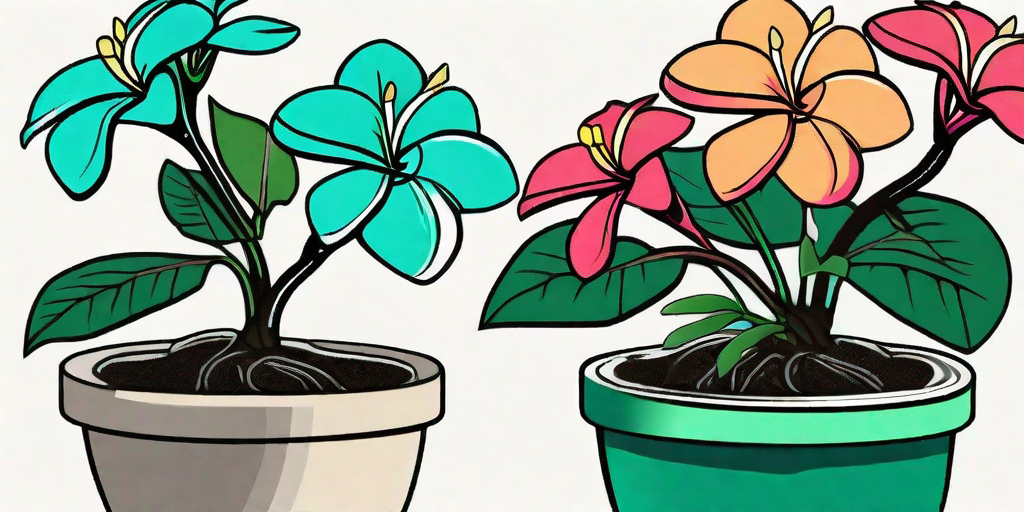
Ah, the Plumeria. A tropical beauty that brings a touch of paradise to your home. But, like any diva, it can be a bit high maintenance. Don't worry, though. We've got you covered. This guide will turn you into a Plumeria pampering pro in no time. So, let's dive in and get your Plumeria blooming again!
Understanding Your Plumeria
Before we get our hands dirty, let's take a moment to understand our green friend. Plumeria, also known as Frangipani, is a tropical plant that loves sun, warmth, and well-drained soil. It's a bit like that friend who loves beach holidays and can't stand the rain. You know the one.
Plumeria plants are famous for their fragrant, vibrant flowers. But, if your Plumeria is looking a bit under the weather, it might be time for a change of scenery. And by that, we mean repotting.
Why Repotting?
Repotting is like moving house for your Plumeria. It gives it a fresh start, with new soil and more space to grow. It's also a chance to check for any pesky pests or diseases. So, if your Plumeria isn't blooming, or if it's been in the same pot for a few years, it might be time for a move.
But don't worry, repotting isn't as scary as it sounds. And, with our guide, you'll be a repotting rockstar in no time.
Getting Ready to Repot
Before you start, you'll need a few things. First, a new pot. It should be a bit bigger than the old one, but not too big. Remember, your Plumeria likes to feel snug. It's a bit like Goldilocks, it wants a pot that's just right.
Next, you'll need some fresh soil. Plumeria likes well-draining soil, so look for a mix designed for cacti or succulents. Or, if you're feeling adventurous, you can make your own mix with equal parts peat moss, perlite, and coarse sand.
Choosing the Right Time
Timing is everything when it comes to repotting. The best time to repot your Plumeria is in the early spring, just before it starts to grow again. This gives it plenty of time to settle into its new home before the growing season starts.
But, if your Plumeria is looking really unhappy, don't wait. A change of scenery might be just what it needs to perk up again.
How to Repot Your Plumeria
Now, the moment you've been waiting for. It's time to repot your Plumeria. Don't worry, we'll guide you through it step by step. So, roll up your sleeves and let's get started.
Step 1: Remove the Plumeria from its Old Pot
First, gently tip the pot on its side and slide the Plumeria out. Be careful not to pull on the stem or you might damage the plant. If it's being stubborn, you can tap the bottom of the pot to loosen it.
Once it's out, check the roots for any signs of disease or pests. If you see anything suspicious, trim off the affected roots with a clean, sharp knife.
Step 2: Prepare the New Pot
Next, fill the new pot with a layer of fresh soil. This will give the roots something to grow into. Make sure the pot has good drainage. Your Plumeria doesn't like wet feet. It's a bit like that friend who refuses to go out in the rain. You know the one.
Place the Plumeria in the new pot and fill around it with more soil. Be careful not to bury the stem too deep. It likes to be above the soil, soaking up the sun.
Step 3: Water and Wait
Once your Plumeria is snug in its new home, give it a good drink of water. But, don't overdo it. Remember, it likes well-drained soil. Then, place it in a sunny spot and wait for it to settle in.
It might take a few weeks for your Plumeria to start growing again. But, with a bit of patience and care, it will soon be blooming like a tropical paradise.
FAQs
Why isn't my Plumeria blooming?
There could be a few reasons why your Plumeria isn't blooming. It might not be getting enough sun, or it might be too cold. Or, it could be that it's time for a repot. If you're not sure, give repotting a go. It might be just what your Plumeria needs to start blooming again.
How often should I repot my Plumeria?
As a rule of thumb, you should repot your Plumeria every 2-3 years. But, if it's looking unhappy, don't wait. A change of scenery might be just what it needs to perk up again.
What kind of soil does Plumeria like?
Plumeria likes well-draining soil. Look for a mix designed for cacti or succulents. Or, make your own mix with equal parts peat moss, perlite, and coarse sand.
Conclusion
And there you have it, the ultimate guide to repotting your Plumeria. With a bit of care and attention, your Plumeria will be blooming again in no time. So, roll up your sleeves and get repotting. Your Plumeria will thank you for it.
Remember, every Plumeria is unique. So, don't be afraid to experiment and find what works best for your green friend. And, most importantly, have fun. After all, gardening is all about enjoying nature and getting your hands dirty. So, go on, get your Plumeria blooming again!















